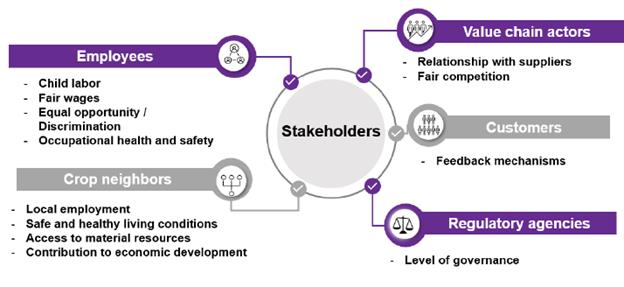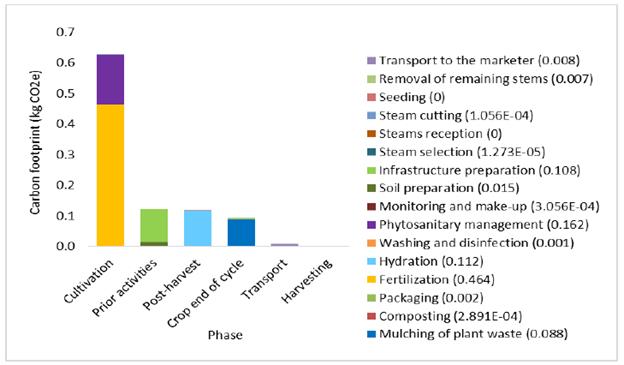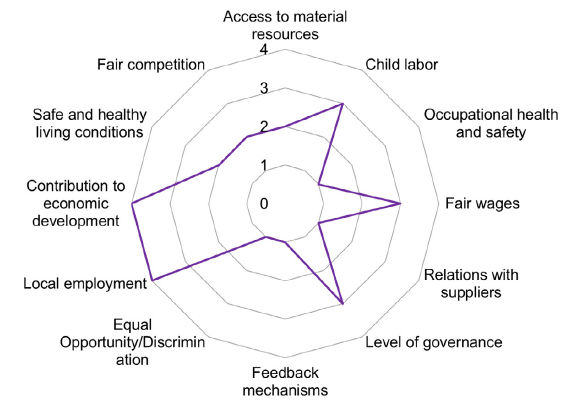INTRODUCTION
The Colombian economy is primarily based on the primary sector production, utilizing raw materials derived from mining and agriculture. Floriculture, including hydrangeas, ranks as the second and third most traded non-mining energy product in the country on a monthly basis [1], representing the second-largest agricultural export in terms of value (with 95% of the country's production exported) [2]. Specifically, there are over 1,500 hectares dedicated to hydrangea production out of 8,000 hectares for Colombian flowers, with 99% produced in Eastern Antioquia [3]. The hydrangea export sector plays a significant role in economic and social development for La Paz province in eastern Antioquia, fostering employment opportunities and enhancing the quality of life in the rural sector.
However, hydrangea floriculture encounters socio-environmental challenges that must be addressed for it to become a sustainable economic activity, especially among small and medium-sized growers. It has emerged as a primary economic sector in the region, displacing other crops (e.g., potatoes). Additionally, it is a favored activity among mothers who are heads of families, thereby promoting women's participation in business processes. Consequently, these production processes have significant environmental impacts throughout their life cycle, and there are social challenges in improving business conditions.
Twelve international research studies on the environmental impacts of floricultural processes under life cycle assessment have been identified and discussed [4, 5, 6]. In Colombia, three floricultural studies have been conducted for hydrangeas, chrysanthemums, and roses. Internationally, studies (especially in Italy) have been conducted for other species. Preliminary results suggest that the most critical environmental impacts in the life cycle are found in the stages of growth, transport, and raw material production.
Environmental and social life cycle assessments present several challenges, such as unreliable information and communication issues, which have been widely acknowledged by governmental and private entities [7, 8]. Nevertheless, life cycle assessments focus on a specific process or product and are intended to guide process and design engineers in modifying systems to reduce global environmental and social impacts [9].
The project 'Environmental, Economic, and Social Life Cycle Assessment for Hydrangea Agro-industrial Enterprises as a Sustainable Development Strategy for La Paz Province in Eastern Antioquia, Colombia' is currently underway. The objective is to identify the social and environmental aspects of hydrangea cultivation by small and medium-sized growers that contribute to environmental impacts and externalities throughout the crop's life cycle. Consequently, actions to reduce or mitigate socio-environmental impacts have been consolidated for implementation by local actors, aiming to enhance the value creation of their production chain in the territory. Indeed, the Life Cycle Assessment (LCA) environmental approach and the Social Life Cycle Assessment (S-LCA) are tools that offer an objective, methodological, systematic, and scientific analysis of impacts related to a product or process during its production cycle. They aim to provide information to identify the most significant environmental impacts for understanding, while prioritizing actions to improve their performance.
MATERIALS AND METHODS
This study included hydrangea production information collected through crop monitoring visits and hydrangea grower interviews, as well as government records of hydrangea production in Colombia. The interviews with growers covered important discussion points, such as health records; pesticide, raw material, and fuel use; labor practices; and working conditions, among others.
The carbon footprint analysis was conducted under a life cycle approach, following the guidelines of ISO 14067:2018. This methodology allows for the identification and quantification of a product's direct and indirect Greenhouse Gas (GHG) emissions during its life cycle, adhering to the International Standards for Life Cycle Assessment (ISO 14040:2007 and ISO 14044:2006) [10, 11, 12]. The Life Cycle Assessment (LCA) consists of four essential stages: Definition of purpose and scope, where the functional unit, data collection, and considered environmental impact categories were defined; inventory analysis; impact assessment; and results interpretation [13]. The social aspects were analyzed following the UNEP (United Nations Environment Programme) guidelines on Social Life Cycle Assessment (S-LCA) of products and organizations, in accordance with the ISO 14040:2007 standard [14].
This study delineates the product system as the production process of exported hydrangeas on a small farm (0.45 ha) located in La Unión (La Paz Province, Department of Antioquia, Colombia). The functional unit was defined as 1 kg of hydrangea stems packed and transported for export to a trading company, produced from a 0.45 ha crop in a 36-week production cycle, corresponding to approximately 12 hydrangea stems.
The scope of application was established from gate-to-gate, encompassing pre-crop establishment activity phases (soil preparation, sowing, and infrastructure preparation); the cultivation phase (fertilization, stalk selection, and plant protection management); harvesting (stalk cutting); post-harvesting (stalk reception, monitoring and conditioning, hydration, and packaging); shipping and transport arrangements; and additional procedures such as washing and disinfection. Finally, the crop life cycle concludes with the removal of remaining stalks, composting, and mulching of plant residues (Figure 1).
The carbon footprint value was determined using the IPCC Global Warming Potential (GWP) values for a 100-year time horizon, sourced from the Ecoinvent 3.8 database. This determination was facilitated through the utilization of Umberto software, enabling the modeling of each stage of the process system. The software matched material and energy consumption data with Ecoinvent process inventories, linking process data with parameter factors (impact indicators), and allowing for the comprehensive analysis of study results. N2O emissions from organic and synthetic fertilizers and CO2 emissions from lime application were determined by following the Intergovernmental Panel on Climate Change (IPCC) methodology for national greenhouse gas inventories - Chapter 11. Additionally, national and international emission factors were used to calculate CO2, N2O, and CH4 emissions from fuel and oil burning and electricity generation.
Through a social analysis, various actors involved in the hydrangea growing process in La Paz Province were identified and prioritized (Figure 2). These actors were classified according to the UNEP categories [14], enabling the analysis of qualitative and quantitative social indicators as defined by UNEP. These indicators were complemented with GRI (Global Reporting Initiative) indicators (Figure 2). To conclude, indicators selected based on the contextual relevance were evaluated using the SAM methodology proposed by [15], illustrating the subcategory of social impact with the most significant influence on the production chain.
1. RESULTS
The carbon footprint assessment of the hydrangea production process resulted in 0.969 kg CO2e per 1 kg of packaged hydrangeas. The growing phase contributed the most, accounting for 64.62% of the total emissions, followed by the prior activities phase (12.67%), post-harvest (11.99%), and final crop cycle (9.90%). Therefore, the harvest and transport phases contributed less than 1% to the carbon footprint (Figure 3).
As depicted in Figure 3, the fertilization process is the largest contributor to the footprint with 0.464 kg CO2e, stemming from the pre-processing of the NPK triple 15 fertilizer (0.243 kg CO2e) and the direct emissions due to its application and compost incorporation (0.221 kg CO2e). These results are influenced by these products increasing the nitrogen bioavailability of the soil, triggering reactions that release nitrous oxide (N2O), a significant greenhouse gas. Similarly, the mulching process of plant wastes on the crop soil results in 0.088 kg CO2e emissions, as N2O is emitted during its decomposition.
Plant protection management also significantly contributes to the carbon footprint with 0.162 kg CO2e, primarily due to direct emissions from fossil fuel use in the pesticide spraying machine (0.062 kg CO2e) and indirect emissions from pre-processing (0.014 kg CO2e), as well as the use of pesticides, notably Mancozeb-based Dithane, contributing 0.062 kg CO2e (Figure 3).
Other aspects that contribute minimally to the carbon footprint include the use of polymeric materials such as polypropylene in the hydrators used during the flower hydration process, and polyethylene from the saran and tutoring mesh used in infrastructure preparation. These materials impact the footprint due to their upstream production and transportation processes, alongside Bamboo poles and other infrastructure materials.
Regarding social issues, certain areas were identified as needing improvement, with occupational health and safety identified as the most significant concern (Figure 4). Hence, it is crucial to implement education and training programs addressing health and environmental risks associated with the improper use of agrochemicals. This includes emphasizing the importance of using personal protective equipment and providing training on minimizing the use of these hazardous chemicals.
2. DISCUSSION OF THE RESULTS
The carbon footprint assessment of the hydrangea production process resulted in 0.969 kg CO2e per 1 kg of packaged hydrangea. This carbon footprint, determined in this study, falls within the range reported by [16], which is between 0.0316 and 5.6 kg CO2e [16]. Furthermore, the fertilization process is the largest contributor to the footprint, accounting for 0.464 kg CO2e. This aligns with [13], which identifies nitrogen as the primary source of fertilizer contributing to the largest emissions [13].
On the other hand, plant protection management also significantly contributes to the carbon footprint with 0.162 kg CO2e. This observation is supported by [17], stating in their study that cut flowers, including hydrangeas, are among the crops requiring the most pesticides for integrated pest management [17]. Enhancing process sustainability can be achieved by implementing cleaner production strategies to reduce the carbon footprint. International agricultural initiatives focus on promoting good agricultural practices, technical solutions for resource efficiency, and waste management. Vital actions include adopting biological controls to replace pesticides, using organic fertilizers instead of synthetic ones, optimizing natural resource utilization, and recovering agricultural residues.
From a social perspective, occupational health and safety emerge as the most critical issues, notably due to inadequate personal protection among growers working with pesticides. Addressing this requires actions to ensure employees use proper personal protective equipment. This finding aligns with [18], highlighting the impact of pesticide exposure on human health. Therefore, recognizing that crop employers are the primary stakeholders potentially most influenced or affected by hydrangea production, it becomes crucial. Additionally, it necessitates the involvement and leadership of other pivotal actors such as hydrangea regulatory bodies to disseminate knowledge on good agricultural practices, marketing companies to fortify sustainability within their value chain, and fostering associative models with other crops.
CONCLUSIONS
The sustainability of the hydrangea production process is compromised by the generation of environmental impacts, such as a carbon footprint of 0.969 kg CO2e per 1 kg of packaged hydrangeas. These impacts are associated with various factors, including the high demand for natural resources and the excessive use of agrochemicals, leading to alterations in soil properties and the utilization of fossil resources (plastics and fuels) at different stages of the process. It is crucial that all efforts aimed at mitigating these impacts prioritize the reduction of agrochemical use, including fertilizers and pesticides, by seeking optimal application levels according to crop needs or by introducing new organic and biological control products.
On the social side, there should be a significant emphasis on occupational health and safety to mitigate the impacts on human health and ecosystems resulting from the use of agrochemicals. This could be strengthened through leadership, knowledge transfer from educational and industry entities, as well as alliances among growers (given their lack of personal protective equipment usage).



















